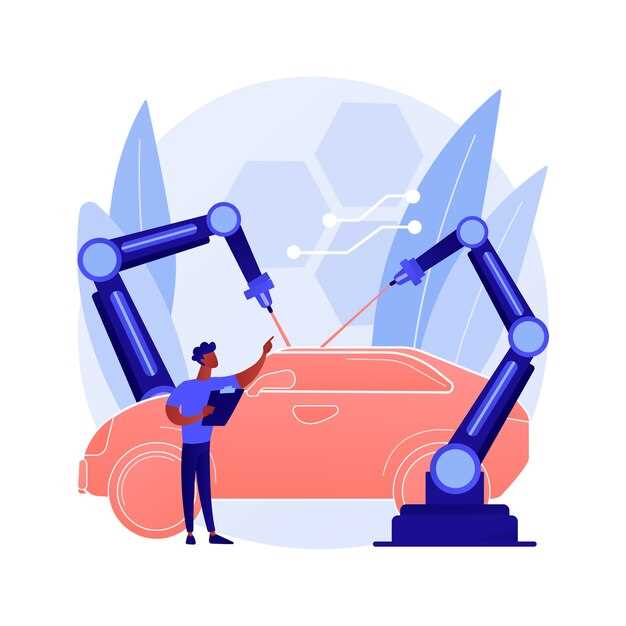To stay competitive, automotive companies should actively integrate AI technologies into their operations. Implementing AI-driven analytics can streamline manufacturing processes, enhance supply chain efficiency, and improve product quality. For instance, predictive maintenance systems, powered by AI algorithms, reduce downtime by anticipating equipment failures before they occur, which can save manufacturers significant costs.
Additionally, AI enhances the customer experience through personalized services. By leveraging data analytics, automakers can offer tailored recommendations, optimizing the sales process. AI chatbots on websites engage customers in real-time, answering inquiries and guiding them through purchasing decisions, thereby increasing conversion rates.
The rise of autonomous vehicles demonstrates AI’s potential to redefine transportation. Companies like Tesla and Waymo lead the charge, employing sophisticated machine learning models that process vast amounts of data from sensors. This technology improves safety and reduces human error, paving the way for widespread adoption of self-driving cars.
Exploring partnerships with tech firms can further accelerate AI implementation. Collaborations bring in specialized expertise, driving innovation and fostering the development of cutting-edge solutions. Automotive companies should consider these alliances a strategic move towards sustainable growth and enhanced market positioning.
Enhancing Vehicle Safety through AI-Powered Systems
Implement advanced driver-assistance systems (ADAS) that utilize AI algorithms to analyze real-time data from cameras and sensors. These systems can detect obstacles, pedestrians, and lane markings, providing alerts and taking corrective actions to prevent accidents.
Integrate adaptive cruise control that adjusts the vehicle’s speed based on the distance to the car ahead, maintaining a safe following distance autonomously. This feature reduces the likelihood of rear-end collisions and ensures a smoother driving experience.
Employ AI-enhanced collision detection systems that predict imminent crashes and automatically engage brakes or adjust steering. Statistics indicate that such systems can reduce serious accidents by up to 40% in urban environments.
Incorporate machine learning models to continuously improve the accuracy of emergency braking systems. These systems learn from diverse driving conditions and scenarios, adapting to various environments and driver behaviors over time.
Utilize AI for predictive maintenance by monitoring vehicle components and alerting drivers of potential failures before they occur. This proactive approach helps avoid breakdowns and dangerous situations caused by mechanical issues.
Integrate voice recognition technologies to minimize driver distraction. Allowing drivers to control navigation, phone calls, and entertainment systems without taking their hands off the wheel or eyes off the road enhances focus and safety.
Employ data analytics from connected vehicles to identify trends and risk factors in real time. Analyzing data across fleets can help manufacturers refine safety features and address vulnerabilities, contributing to overall road safety improvements.
Implement AI-powered traffic management systems that communicate with vehicles to provide real-time updates on road conditions, traffic congestion, and hazards. This information enables drivers to make informed decisions, reducing the risk of accidents.
Optimizing Production Processes with Machine Learning Algorithms
Implement predictive maintenance using machine learning models to forecast equipment failures before they occur. By analyzing historical data and real-time sensor inputs, these models can significantly reduce downtime and maintenance costs. For example, companies that adopt predictive maintenance report a reduction in unplanned outages by up to 40%.
Implement quality control through machine learning algorithms to enhance defect detection. Utilize computer vision systems powered by machine learning to inspect parts on the assembly line. These systems can identify imperfections much faster than manual inspection and reduce scrap rates. One study showed that integrating machine vision reduced production defects by 30%.
Streamline supply chain logistics by leveraging machine learning for demand forecasting. Use historical sales data combined with market trends to predict future product demand accurately. This allows manufacturers to optimize inventory levels, reducing excess stock and improving cash flow. Organizations utilizing these techniques have achieved inventory reductions of 20% on average.
Enhance production scheduling with machine learning algorithms to improve throughput. Create smart scheduling systems that adapt in real-time to changing workflow conditions or unexpected disruptions. Companies applying these techniques report a noticeable increase in production efficiency, often exceeding 25% gains in output.
Implement data-driven decision-making by collecting and analyzing production data across all operations. Build dashboards that visualize key performance indicators (KPIs) and machine learning insights, enabling quick adjustments in processes. Using these insights can lead to informed decisions that elevate overall productivity and reduce operational bottlenecks.
Incorporate clustering algorithms to identify patterns in production processes. Group similar manufacturing cycles or identify outliers to fine-tune individual processes. This data-driven approach helps improve quality consistency and reduces variation, contributing to a more reliable output.
Integrate machine learning with robotics for automated assembly lines. Use adaptive algorithms that allow robots to learn from previous tasks and improve over time. Companies deploying such systems often see reduced cycle times and enhanced flexibility in operations, allowing them to swiftly adapt to changing product lines.
Establish feedback loops in production systems where machine learning can continuously learn and adapt from new data. This approach allows for real-time improvements in processes, ensuring optimal performance throughout production runs. By implementing these feedback mechanisms, manufacturers can maintain high efficiency levels, adapting seamlessly to variations in demand.
Improving Customer Experience with AI-Driven Personalization
Leverage AI capabilities to enhance customer experiences by offering tailored interactions. Start by collecting data from various touchpoints, including online inquiries, service records, and customer feedback. This comprehensive approach enables you to build detailed customer profiles, allowing for relevant communication.
Utilize predictive analytics to anticipate customer needs. For instance, if a customer frequently schedules maintenance at specific intervals, send personalized reminders and promotional offers for relevant services before their typical due date. This proactive measure not only saves customers time but also shows that your brand understands their habits and preferences.
Incorporate chatbots on your website and mobile applications. These AI-powered tools provide instant assistance, answering queries about vehicle features, pricing, and service appointments, thus reducing wait times. Ensure the chatbot can recall previous interactions, making conversations feel seamless and informed.
Segment your customer base to create targeted marketing campaigns. Use AI algorithms to identify trends within specific demographics or regions, tailoring your messaging to align with customer interests. For example, families may appreciate safety features, while tech enthusiasts focus on automotive innovations.
- Offer customized vehicle recommendations based on browsing history and preferences.
- Implement feedback loops by gathering customer responses after service events. Use this data to refine personalization strategies.
Enhance user experience within your mobile app by integrating features like route optimization and fuel tracking. Use AI to personalize content shown to each user, adapting based on their usage patterns and preferred driving styles.
Encourage engagement through loyalty programs powered by AI. Analyze customer interactions and reward frequent users with personalized incentives, such as discounts on services they are likely to use based on their habits.
Train customer service representatives using AI-driven insights to provide a personalized touch. Equip them with data that includes previous interactions, preferences, and service history, allowing for informed conversations and tailored solutions.
By implementing these strategies, automotive companies can significantly improve customer experience. Personalization not only builds relationships but also enhances loyalty, leading to increased satisfaction and retention.
Leveraging AI for Predictive Maintenance in Vehicles
Implement machine learning algorithms to analyze real-time data from vehicle sensors. This enables you to identify patterns that indicate potential issues before they arise. By continuously monitoring parameters such as engine temperature, oil pressure, and brake wear, AI can predict failures, allowing for timely interventions.
Integrate predictive maintenance systems with existing Vehicle Health Monitoring (VHM) technologies. This combination enhances the accuracy of predictions, giving fleet managers insights into which vehicles require maintenance and when. Utilize historical maintenance data alongside current performance metrics to train your algorithms, ensuring they provide the most relevant recommendations.
Adopt cloud-based platforms to aggregate data from multiple sources, including IoT devices. This centralizes information, facilitating seamless analysis with AI tools. Ensure that your data pipeline supports real-time processing to react swiftly to any detected anomalies.
Implement a user-friendly dashboard for technicians, showcasing crucial predictive insights. Visual representations of data help in understanding trends and maintenance needs at a glance, improving decision-making efficiency. Include notifications for impending issues tailored to each vehicle’s specific maintenance schedule.
Incorporate AI-driven chatbots for user queries related to vehicle maintenance. These tools can guide users through basic troubleshooting steps and provide reminders for routine maintenance checks. Enhancing user interaction with AI fosters a proactive maintenance culture.
Regularly update your predictive models with new data. As vehicles evolve and new issues are identified, maintaining an adaptive learning approach ensures the accuracy of predictions over time. Collaboration with automotive experts can also enrich data sets and refine algorithm performance.
Transforming Supply Chain Management with AI Insights
Utilize AI-driven analytics to enhance visibility across your supply chain. Predictive analytics can identify potential disruptions, allowing for timely interventions. Implement tools that analyze historical data and current trends to forecast demand accurately.
Integrate machine learning algorithms for real-time inventory management. These algorithms can optimize stock levels based on consumption patterns, reducing costs associated with overstocking or stockouts. Ensure systems can automatically adjust inventory thresholds based on changing demand signals.
Adopt AI for supplier evaluation and risk management. Use data analysis to assess supplier reliability, quality metrics, and financial stability. Establish a scoring system to prioritize suppliers who align with your business values and risk tolerance.
Implement automated procurement processes to streamline operations. AI can recommend suppliers based on past performance and forecast future requirements. This reduces the time spent on manual tasks, allowing teams to focus on strategic decision-making.
Enhance logistics and transportation through AI routing optimization. AI systems can analyze traffic patterns, weather conditions, and shipment loads to suggest the most efficient delivery routes, minimizing delays and fuel consumption.
Monitor performance using AI dashboards. Create customizable metrics to track KPIs such as lead time, delivery accuracy, and supplier performance. Regularly review these insights to identify areas for improvement.
Foster collaboration among stakeholders by using AI-enabled platforms. These platforms can facilitate information sharing, ensuring all parties have access to the same data and fostering better decision-making.
Invest in training for your workforce to ensure they can effectively leverage AI tools. Provide workshops and resources to enhance their understanding of AI capabilities, maximizing your return on investment.
Exploring Ethical Implications of AI in Autonomous Driving
Analyze the moral dilemmas surrounding decision-making algorithms in autonomous vehicles. Engineers must prioritize transparency in AI systems to allow users to understand how decisions are made during critical situations. Establish clear protocols for how AI should react in scenarios involving potential accidents, prioritizing human safety while maintaining ethical considerations.
Implement diverse perspective teams in AI development. This approach ensures various ethical viewpoints are considered in algorithm design, reducing bias and increasing public trust. Involve ethicists, engineers, and representatives from different community backgrounds to create balanced solutions.
Examine liability structures when accidents occur involving autonomous vehicles. Clear guidelines should dictate responsibility–whether it falls on manufacturers, software developers, or the vehicle operators themselves. These regulations must adapt as technology evolves, ensuring accountability in the automotive sector.
Foster public dialogue regarding the moral implications of AI decisions on the road. Workshops, surveys, and community forums can help gauge public opinion on AI behavior in emergencies. This feedback will guide enhancements to AI algorithms while aligning them with societal values.
Adopt a proactive stance on privacy concerns. As vehicles collect data to improve AI functionality, implementing robust data protection measures is critical. Educate consumers about data usage while ensuring compliance with privacy regulations to build trust.
| Ethical Consideration | Recommended Approach |
|---|---|
| Decision-Making Transparency | Provide clear algorithms and decision paths |
| Diverse Development Teams | Incorporate varied cultural and ethical perspectives |
| Liability Issues | Create clear accountability frameworks |
| Public Engagement | Conduct community discussions on AI practices |
| Privacy Concerns | Implement strong data protection policies |
Stay informed about legislative developments impacting autonomous driving. Collaborate with policymakers to shape laws that address the ethical challenges posed by AI, ensuring a balanced approach to innovation while prioritizing public welfare.






